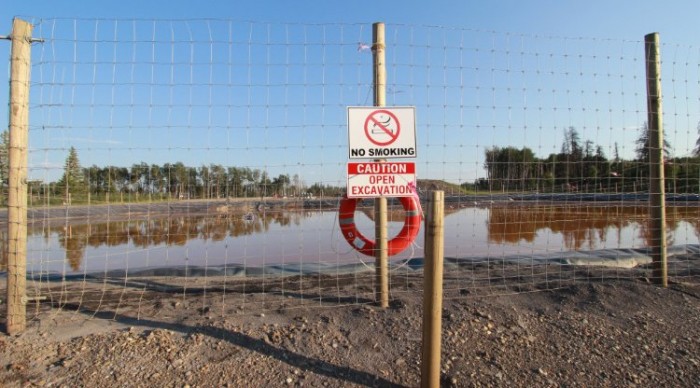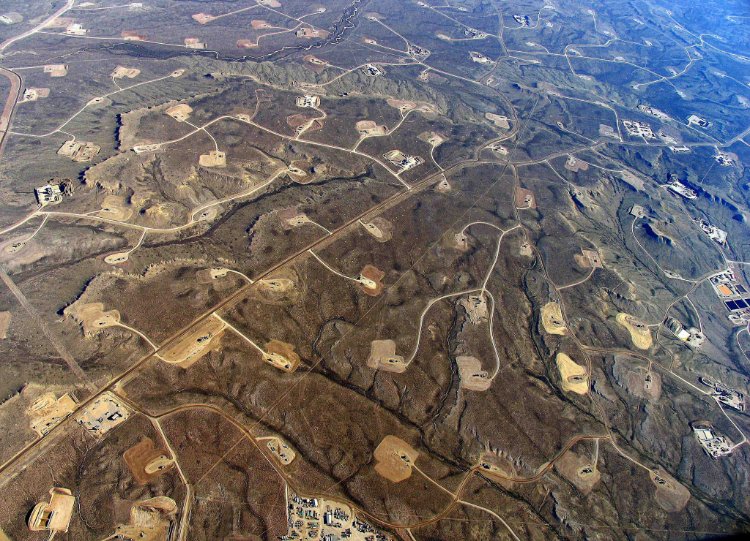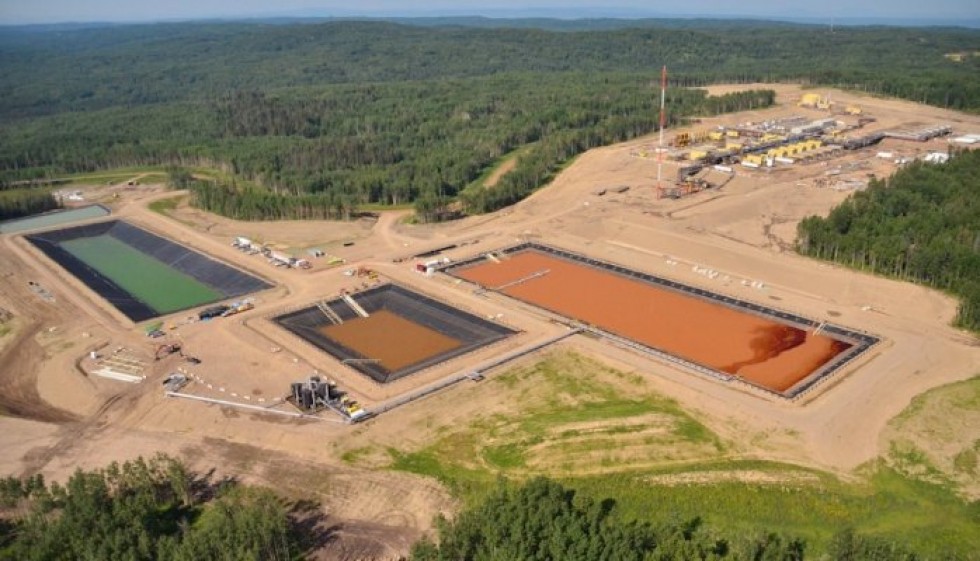Martin Collins, Regional Planner with British Columbia’s Agricultural Land Commission defends fracking as beneficial to livestock and farming.
Sites in the US are known to use as many as 750 chemical additives, many of which are carcinogens
Written by Robert Lundahl, Produced by Robert Lundahl. Originally published in TheECOReport.com.
Part III of The ECOReport/planet rl a Earth Day Investigative Special Report on the Water/Energy Nexus.
Martin Collins, Executive Director of the Agricultural Lands Commission was surprisingly talkative, for someone directly answerable to British Columbia’s Cabinet. Though his superiors, the Chair and six Vice Chairs of the Agricultural Land Commission (ALC), were all appointed by Cabinet or the Ministry of Agriculture, the ALC ostensibly operates as an independent tribunal.
According to the ALC Annual Report 2009/10 the mission of the ALC is as follows: The Agricultural Land Commission (ALC) is the provincial agency responsible for administering the Agricultural Land Reserve (ALR), a provincial land use zone for agriculture. The purposes of the ALC as set out in legislation are:
(a) to preserve agricultural land;
(b) to encourage farming on agricultural land in collaboration with other communities of interest;
and (c) to encourage local governments, First Nations, the government and its agents to enable and accommodate farm use of agricultural land and uses compatible with agriculture in their plans, bylaws and policies.
But this “independence” is convenient for his superiors. Collins was set up, as was the ALC, in a remarkable “responsibility dodge” under the most dire of circumstances, following revelations of the severity of the California drought.
A Ministry of Agriculture spokesperson recently informed the ECOreport that the Agricultural Land Commission (ALC) makes the decisions regarding land zoned for agricultural use. “The ALC is an administrative tribunal – arm’s length from government – and government does not interfere in that independent decision-making process.” He did not mention the fact two weeks prior to our interview, the Cabinet of British Columbia removed land from the ALC — and from agricultural use — for the Site C Dam flooding. Collins said it wasn’t the only time, it had happened three times, in fact, that ALC decisions were intercepted or overridden by the Provincial government.
In his “day job,” Collins is the Regional Planner for the Okanagan, Interior and Northeast regions. Everything about the self professed “paper pusher’s” voice and mannerisms, suggests he would like to be transparent, but Collins is caught in a closing vice between disingenuous government officials practicing a unique and charm-free version of Canadian “double speak,” and the world’s energy producers, hell-bent on fracking British Columbia’s last best agricultural resources and opportunities for food security.
Government officials don’t much care if Collins is squeezed by the avarice of deception on one side and “sector collapse” on the other, as the North American economy spills millions of people into potential deprivation. No water, no food.
Legitimate Issues
The debate over liquid natural gas and fracking practices is ongoing throughout much of North America. The headlines tell the story: “Dead Calves and Hairless Puppies” from Pennsylvania, “Fracking with Our Food” from New York, and from BC, “Toxic Fracking Waste, Illegally Dumped into BC Water Treatment System.”
Dr Allan Hoffman, a former Senior Analyst with the US Department of Energy, believes that with proper regulation and enforcement the number of incidents COULD be reduced to an “acceptable” level. He also admits this is not being done. And what level of toxic compounds, carcinogenic in parts per million (ppm) and parts per billion (ppb), would be “acceptable?”.
Think dioxin, agent orange, DDT. Shouldn’t we let history be our guide? Now it’s Benzine, Acetone, Ammonia, Formaldehyde, Hydrochloric Acid.
Industry and government have only belatedly protected citizens in the past, and the Christy Clark government is giving a good run at becoming the worst and most offensive betrayer of public confidence in the history of the North American continent. Even Nixon didn’t mess with our food. This administration, in response to the California drought, the astonishing undeniable evidence of which is virtually NO SNOWPACK, who, in a province just up the freeway, where Safeway trucks drop their bounty in Vancouver warehouses, and which will shortly produce only 5 percent of it’s food, decides to frack and flood its last best agricultural lands. Where are the criminal indictments?
This kind of analysis does not appear to be taking place within the BC government. Premier Clark has been described as a cheerleader for the liquid natural gas (fracking) industry.
Thus it is refreshing to hear Collins say, “There’s a tension between the Ag(ricultural) industry and Oil and Gas extraction.
But Collins then turns about face faster than a “Whirling Dervish. He continues, “but they also compliment each other. Some farmers make incomes not only from having installations on their property, they actually work for the Oil and Gas industry.”
Continuing Medical Education (CME) Activity Jointly Sponsored by Physicians Scientists & Engineers for Healthy Energy and the Medical Society of the State of New York (Below).
That’s reassuring. The future of health, safety and food security in British Columbia is in the hands of farmers who work for the Oil and Gas industry.
Collins listed the “legitimate issues.” Gas operations disrupt field patterns and their are issues of access to fields. There is an issue of animal health sometimes. Really? Like “Dead Calves and Hairless Puppies?” Pass the lettuce, please.

Photo Credit: A fracking wastewater storage site located on the Farrell Creek road between Fort St John and Hudson’s Hope, BC. Note the “no smoking” sign! – Credit: Joe Foy, Wilderness Committee.
“Industry spokespeople are quick to point out that hydraulic fracturing has been around for years. Fracking – some prefer to call it “fracing” – was first practiced in Canada in the 1950s and decades earlier in the US. Over the past 20 years, however, something entirely new has become the norm: “Multistage, horizontal fracking” using a cocktail of chemicals to flush out stubborn oil and gas deposits.
… All this drilling and fracking generates lots of noise and occasionally earth tremors. Most critically, before a fracked well can enter production, the millions of liters of chemical-laced fluid pumped into it – now contaminated with a host of minerals (some possibly radioactive) – must then be flushed out and discarded. “Produced water” is disposed of in a variety of ways. Alberta farmers are paid to have frack fluids and muds spread on their fields. Some allege that waste frack fluids are spread on public roads.
-David Kattenburg, February 6, 2014, for Deutsche Welle. From Fracking Canada.
“I’m not sure that it is proven, as far as I’m aware it isn’t, but there are issues about well contamination. Water well contamination by oil and gas drilling is a huge issue,” said Collins.
He added that the “digging of ponds through-out the region,” to capture surface water for fracturing, is a bigger issue right now.
Surprisingly, there are no regulations, Collins says, regarding the proximity of wells, up to 20 on a pad, and open ponds for water catchment — ponds servicing wells with fresh water, but also potentially livestock and irrigation. With trucks coming and going, removing “process water” laden with chemicals from wells, the potential is there, he admits, for spillage, airborne transfer, and soils contamination and transfer. The potential, some say the likelihood, for contamination exists. And with farmers minding the water quality, farmers working for the Oil and Gas industry, there is a built-in structural conflict of interest. But he says there is no proof because there are no baseline studies.
In a recent interview pertaining to Maryland’s draft Natural Gas/Fracking legislation, a spokesperson from the Center for Effective Government said it is almost impossible to prove, or disprove, fracking related activities are contaminating water supplies unless there is sufficient groundwater data prior to fracking. Maryland’s draft regulations called for two years of data; BC does not ask for groundwater data prior to fracking. When there is no proof, it is easy, convenient and profitable, particularly for the Christy Clark administration, to suggest there is no problem.
Who can blame Collins for diving under his desk? His superiors in the Provincial government put the ALC in an impossible spot. How can he serve two masters, the oil and gas industry, and the health of farmers, farm families, children, and consumers of agricultural products grown on oil and gas producing farms.
He is in an impossible spot. “There are some other issues that are popping up, but there are also some benefits. Surface water capture helps livestock in the long term and could lead to the possibility of irrigation.”
According to Collins’ analysis, livestock would potentially be drinking water containing pervasive fracking chemicals, delivered by air, by spillage, or by ground seepage, or simply by dumping. Therefore, it would logically follow that people might well eat steak, and pork, and chicken, whose fatty tissues bio-accumulate these chemicals. But this, according to Collins and his bosses in the Christy Clark administration, who of course remain at “arms-length” from the Agricultural Lands Commission, is a “benefit.”
Clearly from the vantage point of a writer in California, we’ve “lost Canada” to the petroleum industry. Welcome to the “New Normal.”
In the United States, about 750 compounds have been listed as additives for hydraulic fracturing, in a report to the US Congress in 2011, after originally being kept secret for “commercial reasons”.
Below is a link to a partial list of the chemical constituents in additives that are used or have been used in fracturing operations, as based on the report of the New York state Department of Environmental Conservation. Some are known to be carcinogenic. The list, which at first glance would seem to include every toxic chemical known to man, is here.
The list of disclosed ingredients used in British Columbian sites, http://www.fracfocus.ca/find_well/BC, is shorter and not exhaustive.
“Frackers are only obliged to monitor their gaseous waste stream for hydrogen sulfide and small hydrocarbons like methane, ethane and propane. The more toxic “BTEXs” – benzene, toluene, xylene and their aldehydes – go unreported,” according to frackingcanada.
Some wells do report formaldehydes and, according to the Lawrence Berkeley National Laboratory:
“Potential cancer risks from formaldehyde have received substantial attention. In 1996 and again in 2006, the International Agency for Research on Cancer (IARC) of the World Health Organization concluded that formaldehyde was a human carcinogen. The primary evidence supporting this conclusion was increases in cancer in workers exposed to formaldehyde concentrations exceeding the concentrations present in most non-occupational indoor environments.”
Collins continues, “It provides a second income to certain farmers. There may be 50 to 70 large farmers in the region and they maybe see oil and gas income as a subsidiary, or smaller, part of their income. Whereas the guy who has a quarter section might have a couple of well sites on it that provide him with $10,000 a year and he has a job somewhere else.”
Temporary Use, Albeit Relatively Long Term

Photo Credit: In areas where shale-drilling/hydraulic fracturing is heavy, a dense web of roads, pipelines and well pads turn continuous forests and grasslands into fragmented islands. from Simon Fraser University via Flickr (CC BY SA, 2.0 License)
“In the long run the Commission, our agency, perceives the oil and gas industry to be a temporary use, albeit relatively long term. We have sense that this is a long term use, but its not permanent. We seek to ensure that whenever installations are put that there is a possibility, and probability, of their being returned to agricultural use.”
Some people question whether a twenty acre gravel pad for multi-well heads, on a twenty well site, will ever be reclaimed for agricultural use.
Quite the optimist, now, Collins responds. “Well, the Oil and Gas industry say that they will and we anticipate that’s what will happen.” .
He said there are already wells that have “gone dry and been reclaimed by farms.” That’s after likely flooding them with Benzene, Hydrochloric Acid, and formaldehydes.
There are farmers “who are less inclined to be supportive” of the gas industry and people “who do not farm much that really like the income,” said Collins.
Apparently the Christy Clark government and the energy industry do as well, well enough to potentially poison the countryside and jeopardize the health of BC citizens in what has to be one of the darkest periods in the history of Canada.
Photo at Top of Page: Fracking site as seen from the air, near Fort St. John, BC. – Credit: Jeremy Sean Williams, WiIderness Committee.


